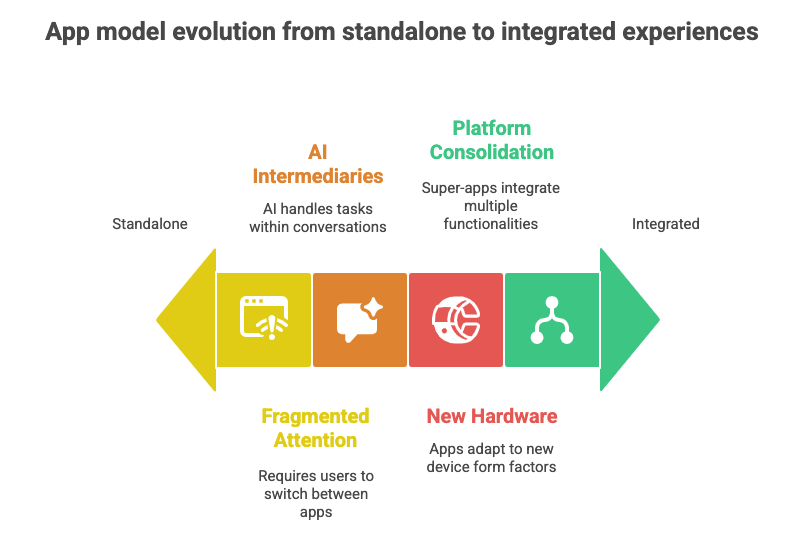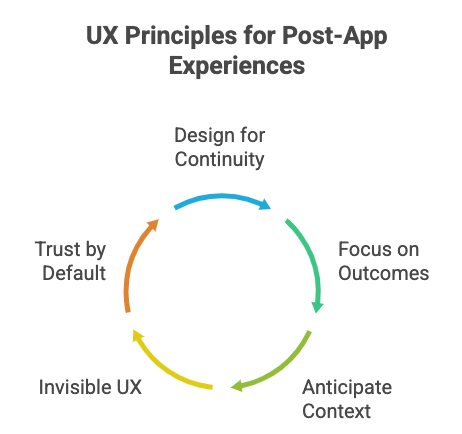Is UX Ready for Post-App Experiences?
What happens when the interface disappears?
For over a decade, apps were the center of digital life. Every product had one. Every brand wanted one. “There’s an app for that” became shorthand for innovation.
But here’s the shift: users aren’t opening apps the way they used to. They’re talking to voice assistants. They’re getting notifications in context. They’re interacting through cars, wearables, smart homes, and AI-driven interfaces that don’t look like apps at all.
This issue explores what UX means in a world where the app is no longer the destination, it’s just one touchpoint in a bigger experience.
From App-Centric to Post-App Ecosystems
Why the App Model Is Breaking Down
5 UX Principles for Post-App Experiences
The Role of AI, Voice, and Ambient Computing
Real-World Signals of the Shift
Risks of Designing with an “App Mindset”
UXCON25 Spotlight: Designing for the Next Interface
Resource Corner
From App-Centric to Post-App Ecosystems
For years, “UX” often meant “designing the app.” A neat, bounded rectangle of flows and patterns. But users don’t live inside rectangles. They move fluidly: from watch to phone, from chat to smart speaker, from browser to AR headset.
Post-app doesn’t mean apps disappear. It means they stop being the center. They become one node in a system.
Why the App Model Is Breaking Down
Fragmented attention: People don’t want to dive into 20 apps a day. They want outcomes, wherever they are.
AI intermediaries: Generative AI pulls actions into conversations (“Book me a flight” → action, no app needed).
New hardware: Watches, glasses, voice assistants - they don’t use the old app container.
Platform consolidation: Super-apps, OS-level integrations, and APIs reduce the need for standalone apps.
The takeaway? The “home screen” isn’t where decisions happen anymore.
5 UX Principles for Post-App Experiences
Design for Continuity
Flows don’t end in your app. They continue across devices and contexts.Focus on Outcomes, Not Screens
Users don’t care if it’s “in the app.” They care if the task is done.Anticipate Context
A reminder at the wrong time is noise. At the right time, it’s value.Invisible UX is Still UX
Even if there’s no screen, the design of timing, tone, and logic still shapes experience.Trust by Default
When interactions move beyond familiar UI, trust signals (explanations, consent, confirmation) become critical.
The Role of AI, Voice, and Ambient Computing
AI: Personal assistants and recommendation engines are quietly making decisions. UX needs to shape how transparent those decisions feel.
Voice: From Alexa to in-car assistants, voice replaces taps with conversation. UX here means language, flow, and fallback paths.
Ambient computing: Devices talk to each other, not just to the user. The UX is in orchestration - making sure it all feels cohesive, not chaotic.
Real-World Signals of the Shift
Apple Vision Pro: Experiences without traditional app navigation - gaze, gestures, and spatial context.
ChatGPT plugins and copilots: Apps are being consumed through AI interfaces.
Tesla dashboards + CarPlay: App-like functions embedded seamlessly into environments.
Risks of Designing with an “App Mindset”
Overloading users with yet another app no one opens
Designing only for screens, ignoring voice, notifications, or context
Thinking about “ownership” of the user journey instead of collaboration across touchpoints
UX in the post-app world requires humility: your app might not be where the experience begins — or ends.
UXCON25 Spotlight: Designing for the Next Interface
At UXCON25, we’ll tackle the question: What is UX when the app isn’t the product anymore?
How one team built continuity across app, voice, and wearable touchpoints
Why AI intermediaries change how we design onboarding
What design leaders predict about the future of “invisible interfaces”
And here’s the best part → Thanks to Great Question’s sponsorship, tickets are more affordable than ever. That means the doors to these conversations, and the community behind them, are now open wider than before.
👉 Join us at UXCON25 and be part of the conversation.
Resource Corner
Final Thought
Apps won’t vanish. But the experience is no longer confined to them.
UX has to grow up from designing flows in boxes to designing relationships across systems.
In the post-app era, the question shifts from “How does the app work?” to “How does the experience feel, everywhere?”






